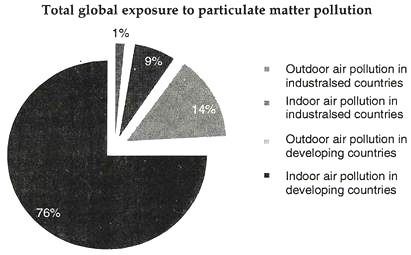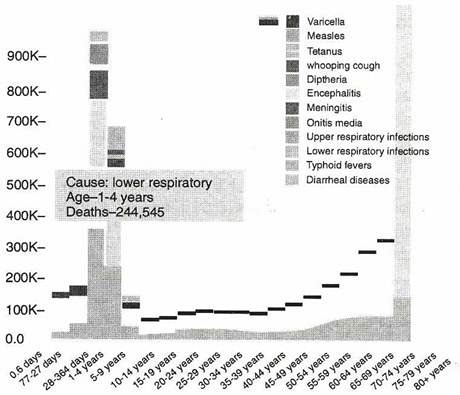Are you looking for an essay on ‘Indoor Air Pollution in India’ for class 8, 9, 10, 11 and 12. Find paragraphs, long and short essays on ‘Indoor Air Pollution in India’ especially written for school and college students.
Essay on Indoor Air Pollution in India
Essay Contents:
- Essay on the Introduction to Indoor Air Pollution
- Essay on the Literature Review of Indoor Air Pollution
- Essay on the Sources of Pollutants of Indoor Air
- Essay on the Measures to Control Indoor Pollution
Essay # 1. Introduction to Indoor Air Pollution:
The human body is the composition of five elements; i.e. Earth or Prithvi; Water or Jal; Fire or Agni; Air or Vayu and then Ether or Akasha. Vayu or Air is one of the basic ingredients of life. Perfect knowledge about air and its importance for human being, indeed very vital for the present generation. If we seriously investigate the cause of pollution, it will be clear before us that the root cause of air pollution is man.
Recent researches have shown that the effect of indoor pollution is more furious compared to outdoor pollution. Report shows that indoor pollution kills millions of people every year. Indoor air pollution is the second biggest killer after high blood pressure in India. Survey says that around 1.3 million people died of indoor air pollution in 2010 whereas death because of outdoor air pollution was around 6.20 lakhs.
This era of technological the advancement is regarded as the greater gift to the mankind. But, in this happiness we forgot to notice that not only outside but; the dangerous effect of technology is found indoor today.
So called intelligent man is quite unaware about the products which are really polluting the internal environment. The list starts from the regular perfume and deodorants to fresh new carpet and different cleaning products. In the wildest of their dream they never thought that the insect killers which kills insect are also silently enters into our body and killing us slowly.
Human beings are unknown about the chlorofluorocarbon coming out from their refrigerator and air conditioners. Smoking becomes the symbol of pride for youngsters which are another reason of killing and even polluting the environment surrounding them.
Other evil products like broken Fluorescent bulbs, different new electronic devices, other plastic products, glues and adhesives, heating equipments (stoves, fire places, heaters and chimneys), paint and strippers, upholstered furniture and pressed wood products, cleaning products, air fresheners, etc. are coming under these category.
Sometime we immediately know its affect. A single exposure invites irritation of eyes, nose and throat which gradually leads to headaches, dizziness and fatigue. These effects are sometime short-lived and can be treated easily. The problem can be vanished with simply eliminating the source of pollutant from nearby areas.
But, in other cases health effects can be noticed after a prolong period. These effects lead to some respiratory diseases, heart diseases, cancer, etc. So it is important to improve the Inside Air Quality (IAQ) in home and indoor areas one spends most of their time.
Essay # 2. Literature Review of Indoor Air Pollution:
A study by WHO said that about 80 per cent of women in India are affected by indoor air pollution. The Tata Energy and Resources Institute (TERI) in a study said that 27.5 per cent of under-five infant mortality in India is because of indoor air pollution. ICMR study in Chennai shows that around 1,200 people showed an increase of 0.3 per cent to 0.6 per cent in mortality with rise in particulate matter pollution by 10 µg/m3.
Approximately half of the world population and up to 90 per cent of rural households in developing countries still rely on unprocessed biomass fuels such as wood, dung and crop residues. This is the main source of pollution. The 1991 National Census for the first time reveled the truth about the fuel used for coking.
It revealed that about 90 per cent of the rural population relied upon the biomass fuels like animal dung, crop residues and wood. A small portion used coal. Nation-wide about 78 per cent of the population relied upon the biomass fuels and 3 per cent on coal.
Analysis of the Study:
Till today many people thinks that air pollution is caused because of automobile exhausts and industrial effluents. However, in developing countries, the problem of indoor air pollution far outweighs the ambient air pollution.
The amount of exposure in terms of the number of people, exposure intensity and time spent exposed is most in the developing world ; approximately 76 per cent of all global participate matter air pollution occurs indoors in the developing world.
Smith K.R. Fuel combustion air pollution, exposure health the situation in developing countries. Annual review of energy environment IB 529-566 (1993).
Essay # 3. Sources of Pollutants of Indoor Air:
There are five primary sources of pollutants of indoor air:
(1) New electronics and other plastic products,
(2) Paints and strippers,
(3)Combustion,
(4) Cleaning products (Many house cleaners, Chemical air fresheners),and
(5) Tobacco smoke.
Apart from these there are many other sources like Air conditioner, refrigerator, New carpets, Shoes, creams and lotions, Candles and incense sticks, etc., Laundry detergent and fabric softeners are also coming under this category.
(1) New Electronics and other Plastic Products:
Products made with polyvinyl chloride can emit phthalates, which have been linked to hormonal abnormalities and reproductive problems. Plastics can also release flame- retardant chemicals, such as polybrominated biphenyl ethers, which have been linked to neurobehavioral changes in animal studies.
(2) Paints and Strippers:
The ingredients in most common paint removers are organic solvents which may damage the skin, eyes, respiratory tract, nervous system, and internal organs. Special precautions must be taken in their use. Especially if there are children present who might come in contact with either the material or its vapors. Health hazards related to chemical paint removers are Respiratory System Damage, Skin Diseases, Damage to Internal Organs, Brain and Nervous System Damage, Fire Hazards.
(3) Combustion:
Indian leaders from the public health, environmental, and security sectors have been requested government to reduce household or indoor air pollution from solid fuels as a major contributor to death early in life. From the 3.5 million deaths caused due to household air pollution worldwide in 2010, many of which were in young children. India, has estimated 100,411 children died as a result of household air pollution that same year.
Globally household air pollution is the cause of more than 50 per cent of deaths from lower respiratory infections among the children under five. The above graphic comes from the Institute for Health Metrics and Evaluation’s GBD (Global Burden of Disease) visualization tool and shows how lower respiratory infections cause many more deaths in children than in most other age groups, underscoring the potential to save a large number of lives by prioritizing interventions that reduce exposure to household air pollution.
(4) Cleaning Products:
U.S. Poison Control Centers reported nearly 10 per cent of all toxic exposures are because of cleaning products. Some cleaners are among the most toxic products found in the home. If I use the wrong ones, I have breathing issues. In 2000, there were 120,434 reported exposures involved children under six to Poison Control. They either swallowed or spilled cleaners stored or left open inside the home.
(5) Tobacco Smoke:
Tobacco smoke contains many pollutants at high concentrations. “Tobacco use kills more than five million people every year – more than HIV/AIDS, tuberculosis and malaria combined.” In developed countries, smoking is responsible for over 80 per cent of cases of chronic bronchitis and for most cases of emphysema and chronic obstructive pulmonary disease.
These studies showed that in India, the incidence of chronic corpulmonale is similar in men and women despite the fact that 75 per cent of the men and only 10 per cent women are smokers.
Essay # 4. Measures to Control Indoor Pollution:
1. Install local exhaust ventilation facilities to deal with the concentrated sources.
2. Ensure proper design and construction of the air conditioning and ventilation systems and keep them in normal operation by good maintenance to provide adequate good quality air (together with enough fresh air) at the places where it is needed.
3. Use an air exchanger or an air cleaner at special locations to improve indoor air quality.
4. Public education: make people aware of the health consequences of poor indoor air quality and the control measures needed to guarantee good indoor air quality.
5. Change in pattern of fuel use from biomass to LPG and solar cooker is highly recommended.
6. To prevent eye irritation caused by splashing, one should wear light-weight plastic splash goggles while pouring or working with paint removers.
7. Ventilation in the kitchen should be given due priority in the design of the houses. In existing houses, measures such as putting a window above the cooking stove and providing cross ventilation through the door may help in diluting the pollution load.
8. Collaboration and commitment between agencies responsible for health, energy, environment, housing and rural development.
9. Before starting a paint removal project, be sure turn off all pilot lights and remove any sources of heat, ultraviolet light, or flame in areas where vapor might drift. In addition, any source of spark or static electricity should be eliminated during use of flammable paint strippers.
10. Solvent-soaked rags should be stored in approved, self- closing oily waste cans, or immediately placed outside. Do not store inside in open wastepaper baskets. Disposal should be done in accordance with local city and fire regulations, and waste-disposal firm may be necessary for large quantities of solvent waste. Never pour solvents down the drain. Small quantities of solvents can be evaporated under a fume hood or outdoors.
11. A National Institute of Occupational Safety and Health (NIOSH)-approved respirator with organic vapor cartridges can help minimize exposure to paint remover vapors if ventilation is not adequate.
12. Gloves should be worn when using paint removers. Ordinary rubber dish washing gloves or surgical gloves will dissolve in paint remover. Neoprene/natural latex blend gloves can withstand most paint remover solvents. If you are going to use steel wool with the paint remover, use cotton gloves over the Neoprene/ latex gloves to protect them from abrasion so they will last longer. To further decrease the risk of skin contact wear long pants, a long sleeve shirt and an apron.
Conclusion:
Air pollution is an alarming danger, slowly which will eat the whole planet if today we will not check or reduce its causes. This paper along with other studies it is clear that the indoor air is about 76 per cent polluted today. It is not only the cause of several health diseases but also the reason of growing death.
It is now the right time to come out from the mask of ignorance and spread the message in the society. Everybody should try to follow the measures to prevent indoor air pollution and make others to follow it too. In this way one day we can make our air pollution free.

